Nothing ruins the elegant look of a wooden table or furniture piece quite like those dreaded white rings left behind by wet glasses and cups. These unsightly marks can appear on any wooden surface, from your grandmother’s antique dining table to your modern coffee table. The good news is that most cup rings aren’t permanent damage and can be removed with the right techniques and a little patience.
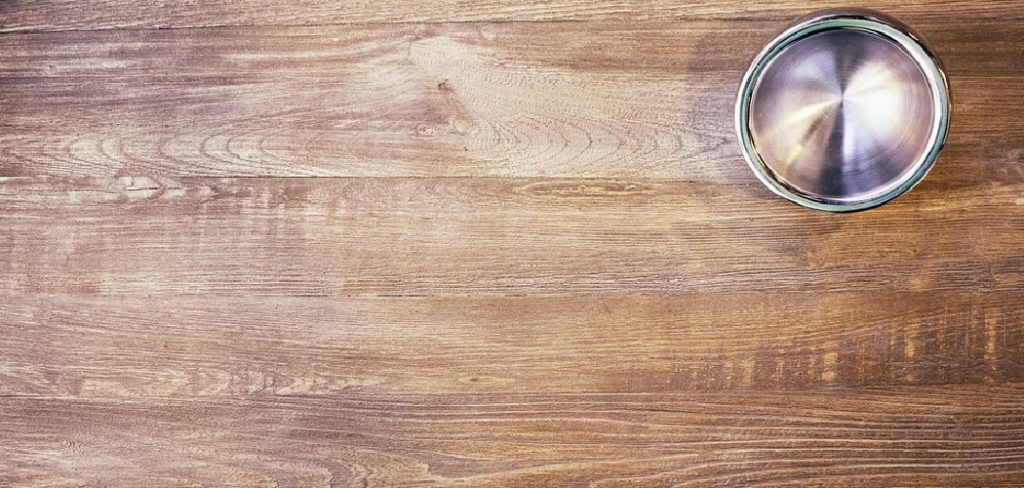
Whether you’re dealing with a fresh water mark or a stubborn ring that’s been there for months, understanding the proper removal methods can save your furniture and restore its original beauty. With common household items and proven techniques, you can tackle this problem without expensive professional services or harsh chemicals. In this article on how to remove a cup ring from wood furniture, we’ll cover the different types of cup rings and the step-by-step process for removing them.
Tools and Materials You’ll Need
- Clean, Soft Cotton Cloths or Microfiber Towels
- Hair Dryer or Heat Gun
- Iron (Clean, No Water in Reservoir)
- Mayonnaise or Petroleum Jelly
- White Toothpaste (Non-gel Formula)
- Baking Soda
- White Vinegar
- Olive Oil or Furniture Oil
- Fine Steel Wool (#0000 Grade)
- Wood Furniture Polish or Wax
- Plastic Wrap or Parchment Paper
- Clean Towels for Protection
8 Simple Step-By-Step Guidelines on How to Remove a Cup Ring from Wood
Step 1: Assess the Damage and Clean the Surface
Begin by carefully examining the cup ring to determine whether it’s a white mark (surface level) or a dark mark (deeper penetration). Use a clean, dry cloth to gently wipe away any dust, debris, or surface dirt from the affected area. This initial cleaning allows you to see the true extent of the damage and ensures that your treatment method will work directly on the stain rather than on surface contaminants.
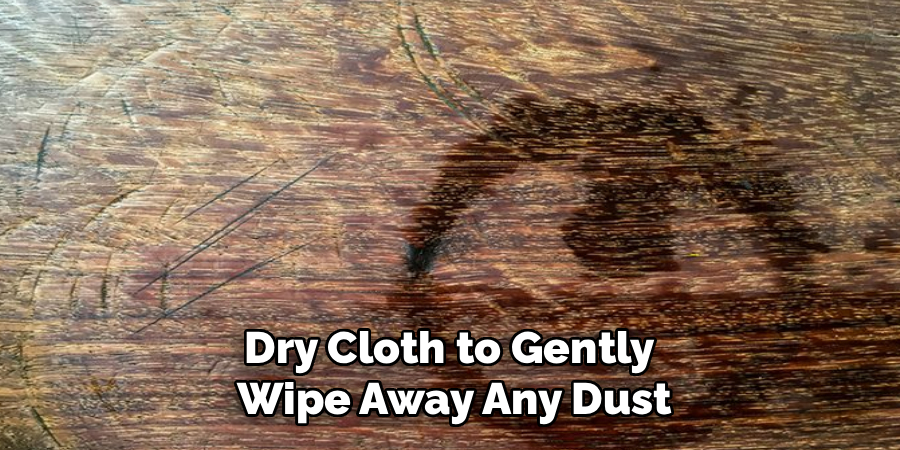
Take note of the wood type and finish, as different woods and finishes may react differently to various treatment methods. If you’re unsure about the wood type or finish, test any treatment method on an inconspicuous area first to avoid causing additional damage to your furniture piece.
Step 2: Try the Heat Method
For white rings, the heat method is often the most effective first approach. Set your hair dryer to medium heat and hold it 6-8 inches away from the mark. Move the dryer in circular motions over the ring for 1-2 minutes, allowing the heat to evaporate trapped moisture in the finish. You should see the white mark begin to fade as the moisture evaporates from the wood’s finish layer.
If you don’t have a hair dryer, you can use a clean iron on low heat. Place a clean, dry cloth over the ring and gently press the iron over the area for 10-15 seconds at a time, lifting and checking progress frequently. Be extremely careful not to overheat the wood or leave the iron in one spot too long, as this can cause permanent damage to the finish.
Step 3: Apply the Mayonnaise Treatment
When heat alone doesn’t work, mayonnaise can be surprisingly effective due to its oil content and mild abrasive properties. Apply a generous amount of mayonnaise directly to the cup ring, ensuring complete coverage of the affected area. The oils in mayonnaise help to restore moisture to dried-out wood finishes, while the slight acidity can help break down mineral deposits left by water.
Allow the mayonnaise to sit on the ring for at least one hour, or even overnight for stubborn marks. Cover the area with plastic wrap to prevent the mayonnaise from drying out and to enhance its penetration into the finish. After the treatment time, wipe away the mayonnaise with a clean cloth and assess whether the ring has lightened or disappeared completely.
Step 4: Use the Toothpaste Method
White, non-gel toothpaste contains mild abrasives that can help polish out surface-level water marks without damaging the wood finish. Apply a small amount of toothpaste directly to the cup ring and gently rub it in circular motions using a soft cloth. The key is to use gentle pressure and work slowly, allowing the mild abrasives in the toothpaste to gradually buff out the cloudiness in the finish.
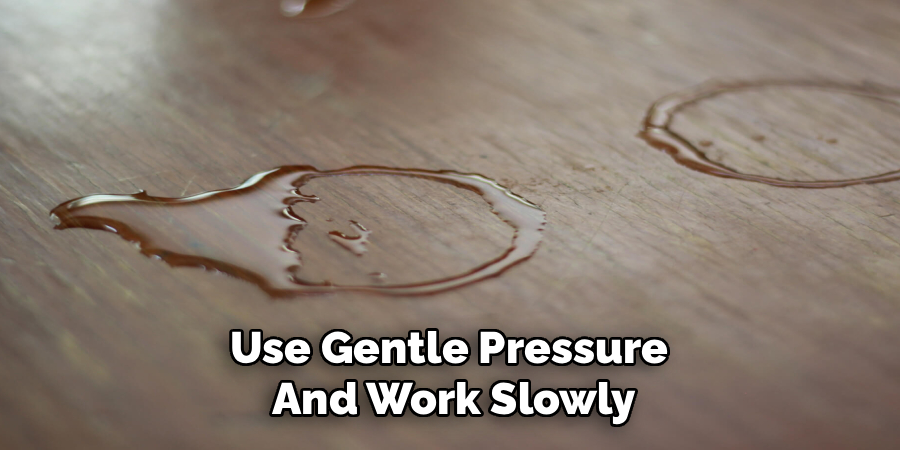
Continue rubbing for 2-3 minutes, adding more toothpaste if necessary. You should begin to see the white ring fade as you work. Once you’ve finished buffing, wipe away all toothpaste residue with a clean, damp cloth, then dry the area thoroughly. Follow up with a light application of furniture polish to restore the wood’s natural shine and protect the newly treated surface.
Step 5: Try the Baking Soda and Oil Paste
Create a paste by mixing equal parts baking soda and olive oil or vegetable oil to form a thick, spreadable consistency. This combination provides gentle abrasive action from the baking soda while the oil helps to nourish and restore the wood finish. Apply the paste to the cup ring using a soft cloth, working it into the mark with gentle circular motions.
Let the paste sit on the ring for 15-20 minutes to allow the ingredients to work on breaking down the water damage and restoring the finish. After the waiting period, use a clean cloth to buff away the paste, working in the direction of the wood grain. The baking soda helps to absorb any remaining moisture while the oil conditions the wood, often resulting in the complete removal of white water rings.
Step 6: Use Fine Steel Wool for Stubborn Marks
For persistent white rings that haven’t responded to gentler methods, very fine steel wool (#0000 grade) can be used as a last resort. This method requires extreme care and should only be used on finished surfaces, never on bare wood. Dip the steel wool in mineral oil or furniture oil to lubricate it and prevent scratching, then very gently rub the ring in the direction of the wood grain using light pressure.
Work slowly and check your progress frequently, as steel wool can remove finish if used too aggressively. The goal is to lightly abrade the cloudy finish layer just enough to restore clarity without creating visible scratches. Once the ring is removed, immediately clean the area with a soft cloth and apply furniture polish to restore protection and shine to the treated area.
Step 7: Address Dark Rings with Vinegar Solution
Dark rings require a different approach since they indicate deeper penetration into the wood itself. Mix equal parts white vinegar and olive oil to create a solution that can help lighten dark water stains. Apply this mixture to the dark ring and let it sit for several hours or overnight, as the acetic acid in vinegar can help break down tannins and other compounds that cause dark staining.
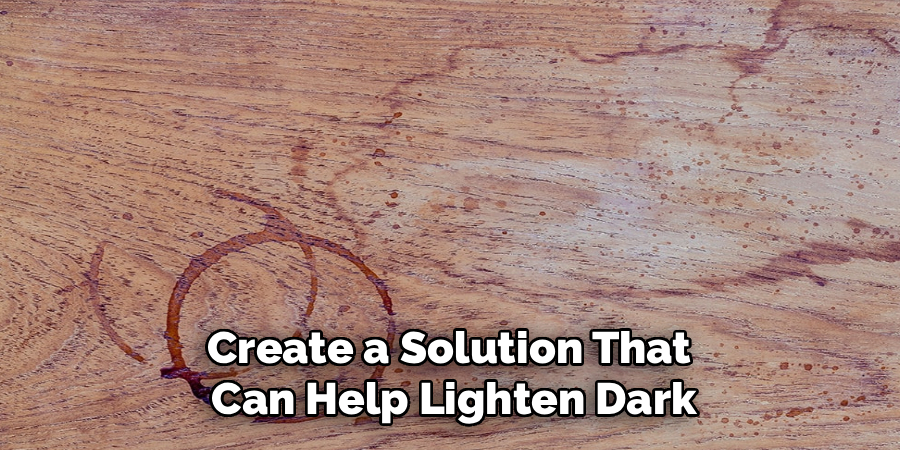
After the treatment period, wipe away the solution and assess the results. Dark rings may require multiple treatments or may need to be sanded and refinished if the damage is too severe. If this method doesn’t show significant improvement after 2-3 applications, the damage may be too deep for home remedies, and professional restoration might be necessary.
Step 8: Final Polishing and Protection
Once you’ve successfully removed the cup ring, it’s important to restore the wood’s finish and protect it from future damage. Clean the entire surface with a soft cloth to remove any residue from your treatment methods. Apply a high-quality furniture polish or wax according to the manufacturer’s instructions, working in the direction of the wood grain to ensure even coverage.
Allow the polish or wax to dry according to product instructions, then buff the surface to a natural shine using a clean, soft cloth. This final step not only restores the wood’s appearance but also provides a protective barrier against future water damage. Consider applying a fresh coat of furniture wax every few months to maintain this protection.
Following these steps on how to remove a cup ring from wood furniture will help you restore your wooden surfaces to their original beauty. However, prevention is always better than cure. To avoid getting cup rings on your wood furniture in the future, be sure to use coasters or placemats under drinks and clean up spills immediately.
Preventing Future Cup Rings
Use coasters, placemats, or trivets under all glasses, cups, and hot dishes to create a barrier between wet or hot items and your wood surfaces. Immediately wipe up any spills or condensation that occurs, as even small amounts of moisture can cause rings if left to sit.
Apply furniture wax or polish regularly to maintain a protective barrier on your wood surfaces, making them more resistant to water damage. Consider using tablecloths or protective pads during meals and entertaining to provide an extra layer of protection. Keep humidity levels in your home between 30-50% to prevent wood from becoming overly dry and more susceptible to water damage.
When to Call a Professional?
Professional help becomes necessary when cup rings are very dark or black, indicating deep penetration into the wood that requires sanding and refinishing. If you’ve tried multiple home remedies without success, or if the ring appears to be getting worse with treatment, it’s time to consult a furniture restoration expert. Antique or valuable furniture should always be treated by professionals to avoid diminishing their value with improper DIY repairs. When the ring is accompanied by other damage like cracking, warping, or extensive finish damage, professional assessment and repair are essential.
Additionally, if you’re uncomfortable with any of the removal methods or lack confidence in your abilities, professional services ensure safe and effective restoration while preserving your furniture’s integrity and value.
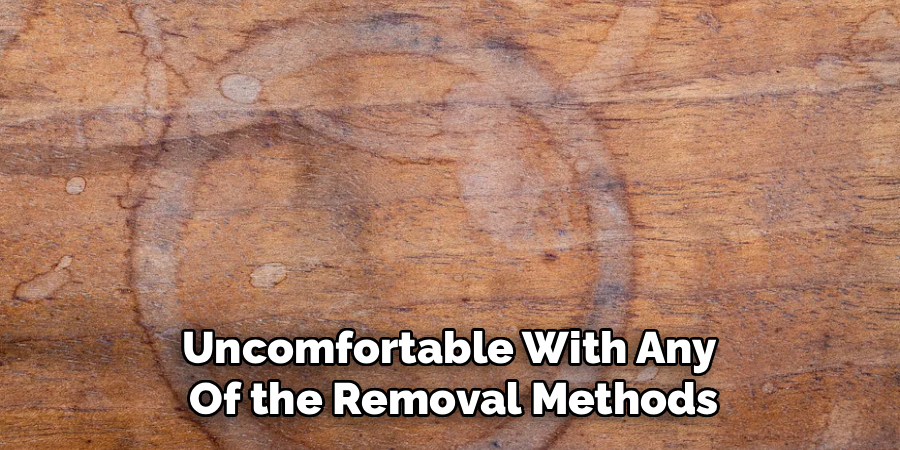
Frequently Asked Questions
Q: Can Cup Rings Be Permanently Removed From Wood?
A: Most cup rings can be successfully removed, especially white rings that only affect the surface finish. The key factor is how deeply the moisture has penetrated into the wood. White rings, which are the most common type, typically respond well to home treatment methods because they only affect the top finish layer. However, success depends on acting quickly and using the appropriate method for your specific type of wood and finish. Dark rings that have penetrated into the wood itself are more challenging but can often be lightened significantly or removed entirely with proper treatment, though they may require professional intervention for complete removal.
Q: How Long Does It Take To Remove A Cup Ring?
A: The time required varies significantly depending on the method used and the severity of the ring. Simple heat treatment can work in just a few minutes for fresh, light rings, while methods like mayonnaise or oil treatments may require several hours or overnight application. Most successful treatments show visible improvement within the first application, but stubborn rings may require repeated treatments over several days. Patience is crucial – rushing the process by using excessive heat or pressure often causes more damage than the original ring. Generally, you should allow at least a few hours to a full day for most treatment methods to work effectively.
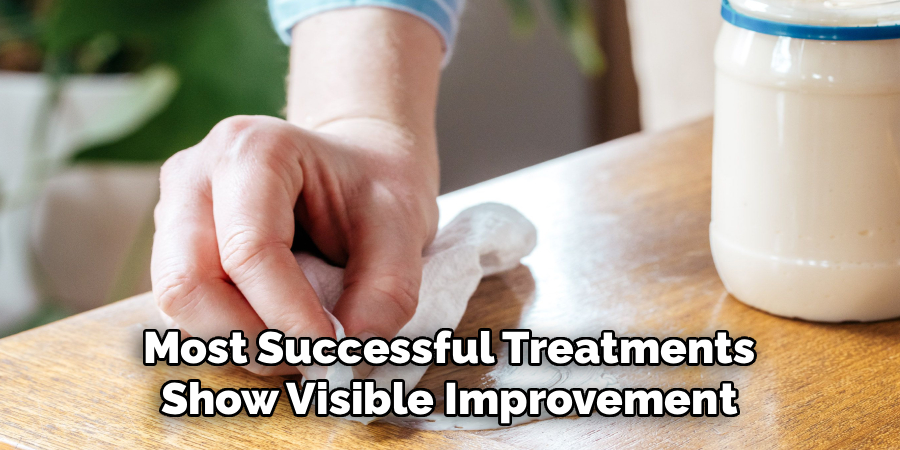
Conclusion
Removing cup rings from wood doesn’t have to be a daunting task when you understand the proper techniques and take a patient approach. Most white rings can be successfully eliminated using common household items and gentle methods, while dark rings may require more intensive treatment or professional help.
The key to success lies in acting quickly when rings occur, using the appropriate method for your specific situation, and always prioritizing gentle techniques over aggressive approaches. Remember that prevention is always better than cure – using coasters and maintaining your furniture properly will save you time and effort in the long run while preserving the beauty and value of your wooden pieces. Thanks for reading this article on how to remove a cup ring from wood.
About
Team Woodlix is a distinguished figure in the world of Diy design, with a decade of expertise creating innovative and sustainable Diy solutions. His professional focus lies in merging traditional craftsmanship with modern manufacturing techniques, fostering designs that are both practical and environmentally conscious. As the author of diy, Woodlix delves into the art and science of furniture-making, inspiring artisans and industry professionals alike.
Education RMIT University
(Melbourne, Australia) Associate Degree in Design (Team Woodlix) Focus on sustainable design, industry-driven projects, and practical craftsmanship. Gained hands-on experience with traditional and digital manufacturing tools, such as CAD and CNC software.
Nottingham Trent University
(United Kingdom) Bachelor’s in diyfastly.com and Product Design (Honors) Specialized in product design with a focus on blending creativity with production techniques. Participated in industry projects, working with companies like John Lewis and Vitsoe to gain real-world insights.
Publications and Impact
In diy, Team Woodlix his insights on indoor design processes, materials, and strategies for efficient production. His writing bridges the gap between artisan knowledge and modern industry needs, making it a must-read for both budding designers and seasoned professionals.
